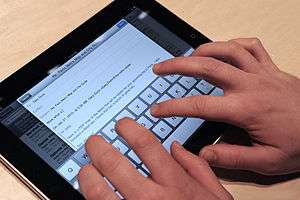Virtual keyboard

A virtual keyboard is a software component that allows a user to enter characters.[1] A virtual keyboard can usually be operated with multiple input devices, which may include a touchscreen, an actual computer keyboard and a computer mouse.
Types
On a desktop computer, a virtual keyboard might provide an alternative input mechanism for users with disabilities who cannot use a conventional keyboard, or for bi- or multi-lingual users who switch frequently between different character sets or alphabets, which may be confusing over time. Although hardware keyboards are available with dual keyboard layouts (e.g. Cyrillic/Latin letters in various national layouts), the on-screen keyboard provides a handy substitute while working at different stations or on laptops, which seldom come with dual layouts.
Virtual keyboards are commonly used as an on-screen input method in devices with no physical keyboard, where there is no room for one, such as a pocket computer, personal digital assistant (PDA), tablet computer or touchscreen-equipped mobile phone. Text is commonly inputted either by tapping a virtual keyboard or finger-tracing.[2] Virtual keyboards are also used as features of emulation software for systems that have fewer buttons than a computer keyboard would have.
Virtual keyboards can be categorized by the following aspects:
- Physical keyboards with distinct keys comprising electronically changeable displays integrated in the keypads
- Virtual keyboards with touchscreen keyboard layouts or sensing areas[3]
- Optically projected keyboard layouts or similar arrangements of "keys" or sensing areas[4][5]
- Optically detected human hand and finger motions[6]
- Virtual keyboards to allow input from a variety of input devices, such as a computer mouse, switch or other assistive technology device.
- Online virtual keyboards for multiple languages that don't require OS settings change[7]
An optical virtual keyboard was invented and patented by IBM engineers in 2008.[6] It optically detects and analyses human hand and finger motions and interprets them as operations on a physically non-existent input device like a surface having painted keys. In that way it allows to emulate unlimited types of manually operated input devices such as a mouse or keyboard. All mechanical input units can be replaced by such virtual devices, optimized for the current application and for the user's physiology maintaining speed, simplicity and unambiguity of manual data input.
On the Internet, various JavaScript virtual keyboards have been created, allowing users to type their own languages on foreign keyboards, particularly in Internet cafes. Multitouch screens allow the possibility to create virtual chorded keyboards for tablet computers,[8] touchscreens, touchpads and wired gloves.[9][10]
Security considerations
Virtual keyboards may be used in some cases to reduce the risk of keystroke logging.[11] For example, Westpac’s online banking service uses a virtual keyboard for the password entry, as does TreasuryDirect (see picture). It is more difficult for malware to monitor the display and mouse to obtain the data entered via the virtual keyboard, than it is to monitor real keystrokes. However it is possible, for example by recording screenshots at regular intervals or upon each mouse click.[12][13]
The use of an on-screen keyboard on which the user "types" with mouse clicks can increase the risk of password disclosure by shoulder surfing, because:
- An observer can typically watch the screen more easily (and less suspiciously) than the keyboard, and see which characters the mouse moves to.
- Some implementations of the on-screen keyboard may give visual feedback of the "key" clicked, e.g. by changing its colour briefly. This makes it much easier for an observer to read the data from the screen. In the worst case, the implementation may leave the focus on the most recently clicked "key" until the next virtual key is clicked, thus allowing the observer time to read each character even after the mouse starts moving to the next character.
- A user may not be able to "point and click" as fast as they could type on a keyboard, thus making it easier for the observer.
See also
Notes
- ↑ "virtual keyboard". PCMag.
- ↑ "Swype finger-tracing text entry seems fast, hypnotic, and magical". Engadget. Retrieved 2016-03-24.
- ↑ US application 4725694 Auer Carol M, Castagno Daniel L/AT&T: "Computer interface device" priority date 13.05.1986
- ↑ DE application 19734511 B. Kämmerer, C, Maggioni, H. Röttger/SIEMENS AG: "Kommunikationseinrichtung" filing date 08.08.1997
- ↑ WO 0003348 C. Maggioni, B. Kämmerer/SIEMENS AG: "Projection Device / Vorrichtung zur Projektion" priority date 10.07.1998
- 1 2 EP 0554492 Hans E. Korth: "Method and device for optical input of commands or data" filing date 07.02.1992
- ↑ "Virtual keyboard".
- ↑ Chien-Hsu Chen. "Design and Evaluation of Chord Keyboard for Tablet Computer Manipulation". National Cheng Kung University.
- ↑ "ASETNIOP concept designed to make touch typing on a touchscreen a mite easier". Gizmag.com.
- ↑ "ASETNIOP invisible keyboard aims to get you touch-typing on the iPad". todaysiphone.com.
- ↑ "Virtual keyboard".
- ↑ Lake Software: Does not defeat keyloggers!
- ↑ Smith, David A. (2006-06-21), Outsmarting Keyloggers, PC Magazine, retrieved 2009-11-16
External links
| Wikimedia Commons has media related to Virtual keyboards. |
- Microsoft Codeplex: An open source on-screen keyboard
- Microsoft: Using On–Screen Keyboard
- Multi-Lingual: Virtual Keyboard Layouts